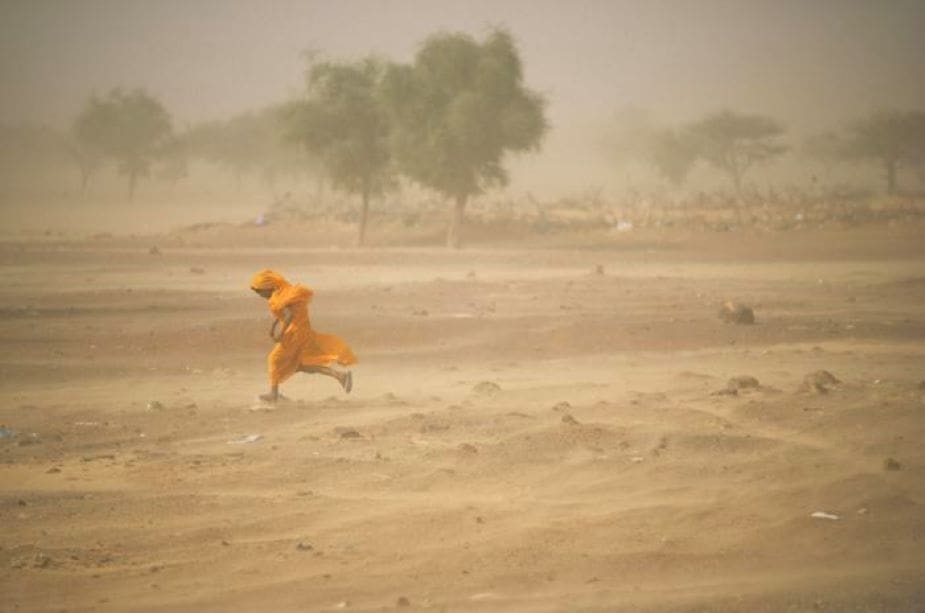Explore the latest insights from top science journals in the Muser Press daily roundup (July 11, 2025), featuring impactful research on climate change challenges.
In brief:
Global soil organic carbon levels on the rise due to climate change
The research, conducted by a team of scientists including Yanli Liu, Xin Chen and Jianyun Zhang, utilized a random forest model to analyze historical data and predict future trends of SOC levels based on climate scenarios from the Coupled Model Intercomparison Project Phase 6 (CMIP6).
The study examined global land surface SOC trends from 1981 to 2019 and identified the driving factors behind these changes. The results indicate that the global surface SOC content is on the rise, with temperature and precipitation emerging as the primary climate drivers at the global scale. Vegetation cover was also found to be a crucial local factor influencing the increase in SOC. However, the research highlights that relying solely on natural carbon sinks to achieve global carbon neutrality is a high-risk strategy, as the projected increase in SOC is far from the ambitious targets set by the Paris Agreement.
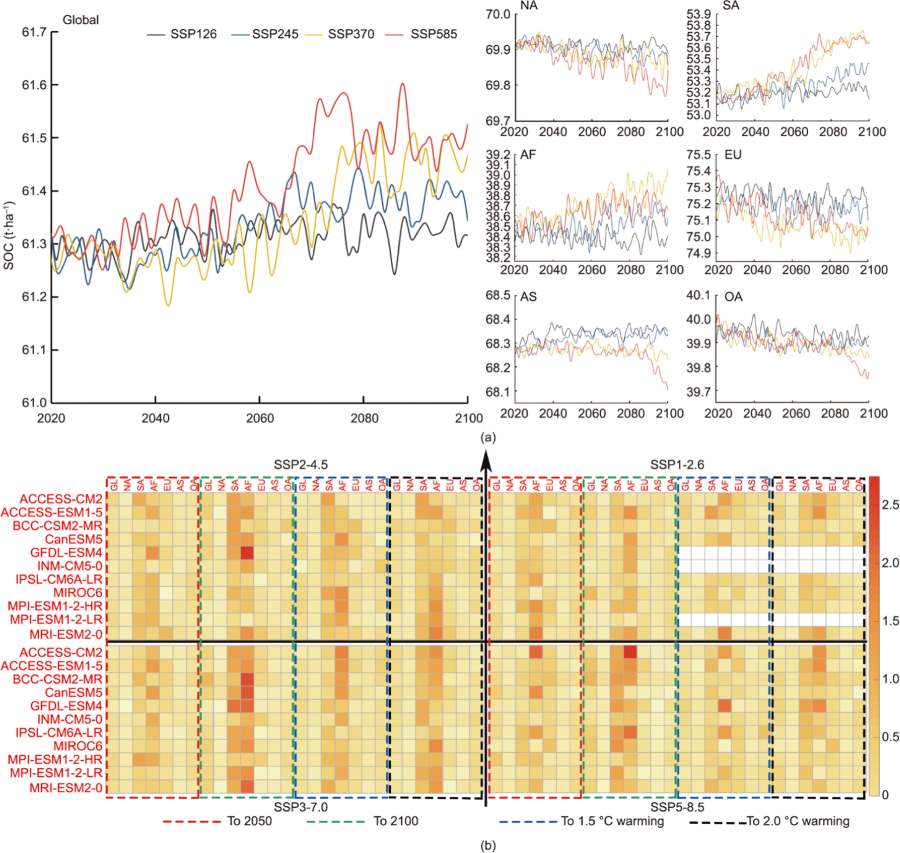
The historical analysis revealed that the global SOC stock increased by 6.392 petagram carbon (PgC) from 1981 to 2019. This increase was particularly notable in middle- and low-latitude regions, where vegetation cover is more extensive. The study also found that high-latitude regions, such as parts of North America, Asia, and Europe, experienced a significant decrease in SOC, which could be attributed to the effects of global warming on frozen soils.
The researchers employed the geographical detector model to analyze the driving factors of global SOC change. The results showed that temperature, leaf area index (LAI), and rainfall days are the main factors affecting SOC variation globally. The study also highlighted the complex interactions between these factors, which can either enhance or diminish the impact on SOC levels depending on the region.
Using the random forest model, the researchers projected future SOC trends under different climate scenarios. The model predicted that the global SOC stock will continue to increase under all scenarios, with the most significant growth expected in Africa and South America. However, high-emission scenarios, such as SSP5-8.5, could lead to notable declines in SOC in North America, Asia, and Oceania by 2100.
The study emphasizes the importance of implementing mitigation and removal strategies to reduce greenhouse gas emissions, as natural land-based mitigation alone is insufficient to meet the Paris Agreement’s target of a four out of one thousand increase in soil carbon stocks per year over the next 20 years. The findings suggest that achieving global carbon neutrality will require a combination of natural carbon sequestration and human-induced measures.
The research underscores the need for comprehensive monitoring systems and advanced data processing techniques to improve the accuracy of SOC projections. It also highlights the potential risks associated with over-reliance on natural carbon sinks and the urgency of developing effective land and soil management strategies to enhance soil carbon sequestration.
The study provides valuable insights into the dynamics of global SOC levels and the role of climate change in driving these changes. The findings emphasize the importance of a balanced approach to carbon mitigation, combining natural processes with human-induced strategies to achieve global carbon equilibrium.
Journal Reference:
Yanli Liu, Xin Chen, Jianyun Zhang, Xing Yuan, Tiesheng Guan, Junliang Jin, Guoqing Wang, ‘Nature-Based Global Land Surface Soil Organic Carbon Indicates Increasing Driven by Climate Change’, Engineering (2025). DOI: 10.1016/j.eng.2025.03.031
Article Source:
Press Release/Material by Higher Education Press
Climate change anxiety: The hidden force driving disaster preparedness in California’s fire country
The research, published online in BMJ Mental Health, surveyed more than 800 Lake County residents at the beginning of the 2023 wildfire season.
Findings include:
- Residents who had prior experiences with wildfires and greater exposure to wildfire-related media were more likely to report higher levels of climate change anxiety and anticipatory stress about future climate disasters.
- Those reporting higher anxiety and stress were more likely to have prepared emergency kits and power outage supplies for the upcoming fire season.
- Climate change anxiety and anticipatory stress were also associated with greater intentions to evacuate if instructed during a wildfire.
“Our findings suggest that a certain level of anxiety and stress about climate change may actually be adaptive, motivating important disaster preparedness actions,” says Tiffany Junchen Tao, UC Irvine doctoral student in clinical psychology and first author of the paper. “However, it’s critical to distinguish between reasonable concern and debilitating distress.”
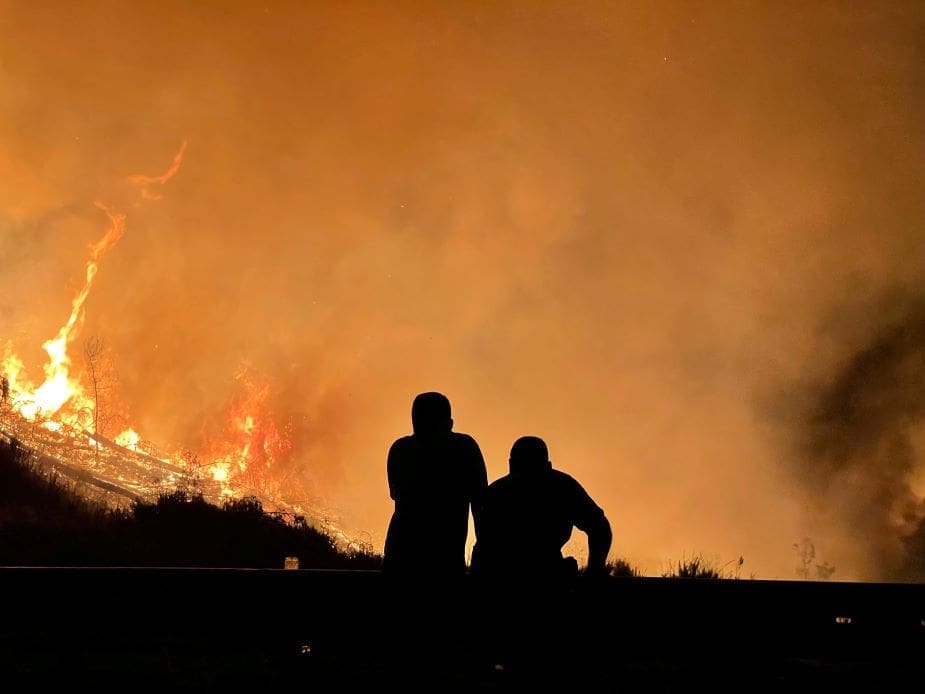
As climate-related disasters increase, understanding the psychological responses of vulnerable communities is crucial, says senior author Roxane Cohen Silver, UC Irvine vice provost of institutional research, assessment, and planning and distinguished professor of psychological science, medicine, and public health. “Our results can inform emergency management and mental health interventions in similar high-risk regions globally.”
Tao and Silver co-authored the study with Kayley D. Estes, UC Irvine postdoctoral scholar; E. Alison Holman, UC Irvine professor of nursing; and Farshid Vahedifard, Tufts University professor of civil and environmental engineering.
Their research provides insights that could help tailor disaster preparedness strategies for high-risk communities, particularly those facing socioeconomic challenges. The researchers emphasize the importance of providing resources to help disadvantaged residents engage in disaster preparation.
“Among residents in communities that have experienced significant climate-related disasters, prior experiences with climate disasters were associated with climate change anxiety and anticipatory climate stress, which were themselves related to preparedness for another climate disaster,” they note. “These findings have deepened our understanding of how psychological processes are implicated in coping with wildfires, as well as human behaviors in a disaster context. They bear value in informing future interventions to promote self-protective preparatory behaviors to prevent and mitigate the worst impacts of climate-related disasters.”
Journal Reference:
Tiffany Junchen Tao, Kayley D Estes, E Alison Holman, Farshid Vahedifard, Roxane Cohen Silver, ‘Understanding climate change anxiety and anticipatory climate disaster stress: A survey of residents in a high-risk California county during wildfire season’, BMJ Mental Health 28, 1: e301331 (2025). DOI: 10.1136/bmjment-2024-301331
Article Source:
Press Release/Material by Mimi Ko Cruz | University of California – Irvine (UC Irvine)
Origin and diversity of Greenland’s ancient sled dogs
Genomic insights into Greenland’s iconic sled dog reveal a rich history of Inuit migration and Arctic adaptation, according to a new study. The findings provide a crucial guide for preserving the ancient breed amid climate threats and rapid cultural change. For over 9,500 years, sled dogs have been a central part of Arctic life.
While many Arctic sled dog breeds have been replaced, mixed with other dogs, or shifted into domestic roles, the Greenland sled dog, or Qimmeq | Quimmiq (pl. Qimmit), has uniquely preserved its traditional role as a working sled dog. However, this ancient working relationship now faces modern threats: climate change, urbanization, and modern technologies like snowmobiles are rapidly eroding the conditions that have long supported Qimmit and their traditional role. The ongoing decline in Qimmeq population underscores the urgency of documenting their remaining genetic diversity to guide conservation efforts.
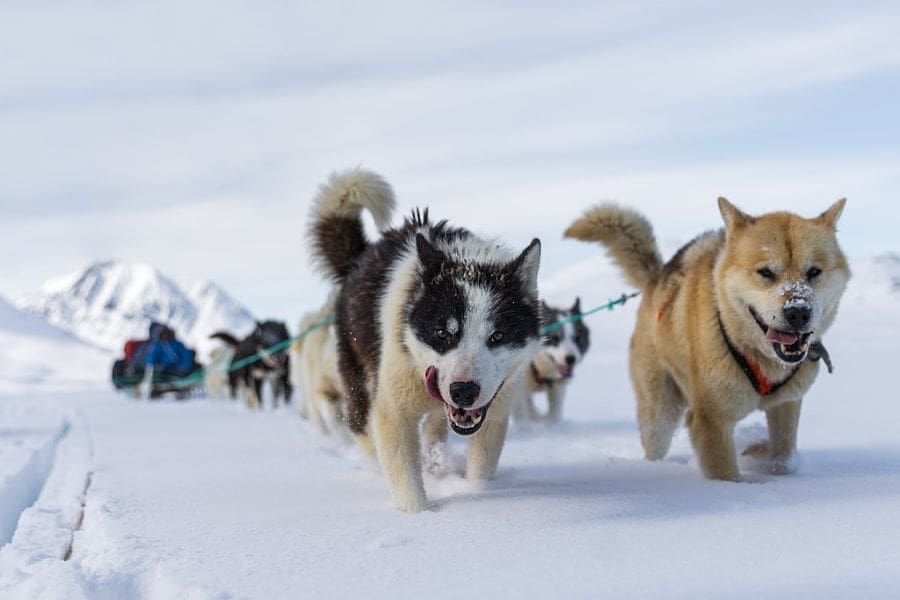
To reconstruct the breed’s history, Tatiana Feuerborn and colleagues sequenced genomes from 92 dogs across Greenland spanning the past 800 years, capturing both ancient and modern individuals, and compared them with over 1,900 published dog genomes. Feuerborn et al. discovered that Qimmit form a distinct clade with other ancient Arctic dogs – most notably a 3,700-year-old Alaskan dog. This genetic continuity, despite thousands of years and great geographic distances, supports the theory of a rapid Inuit migration across the North American Arctic.
Notably, the authors found that the genetic differentiation among regional dog populations mirrors the cultural and linguistic divisions of the indigenous peoples of Greenland. Moreover, the analysis revealed further evidence of two distinct migrations of dogs into Greenland, with data that indicate an earlier-than-expected arrival of people to the region. Feuerborn et al. also show that despite European colonization of Greenland, there is minimal European ancestry in present-day Qimmit, likely due to overall isolation of the populations and more modern preservation policies.
“These insights into the Qimmit provide a baseline for levels of inbreeding and introgression that can serve as a foundation for informed management aimed at the preservation of these remarkable dogs,” write the authors. “Studies such as this demonstrate the relevance of paleogenomic insight into current conversations and decisions centered around conservation and preservation of culturally significant species.”
Journal Reference:
T. R. Feuerborn et al., ‘Origins and diversity of Greenland’s Qimmit revealed with genomes of ancient and modern sled dogs’, Science 389, 6756, 163-168 (2025). DOI: 10.1126/science.adu1990
Article Source:
Press Release/Material by Walter Beckwith | American Association for the Advancement of Science (AAAS)
Beetles under climate stress lay larger male eggs
Researchers at Kyushu University have found that when azuki bean beetles infected with Wolbachia bacteria are exposed to a simulated climate change environment – characterized by elevated temperature and carbon dioxide – they tend to produce larger eggs to enhance the survivability of their offspring. Interestingly, these larger eggs gave rise exclusively to male larvae.
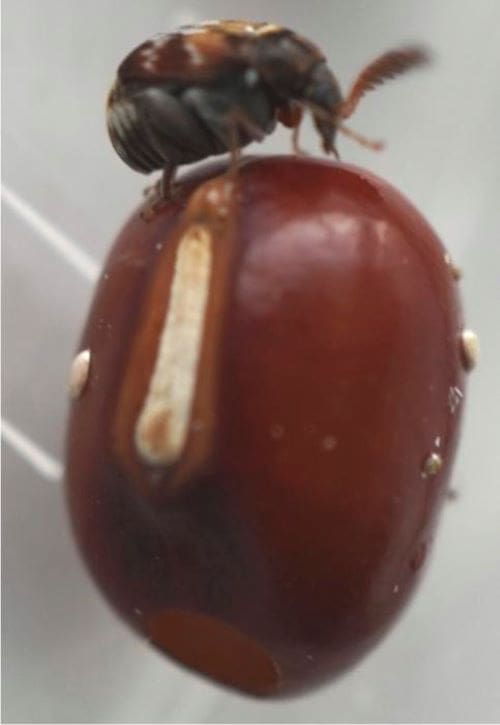
The study, published in Scientific Reports, demonstrates the benefits of Wolbachia infection under adverse environmental conditions in these beetles. It is also the first observation of sex-dependent changes in egg size in a species with chromosomal sex determination.
The azuki bean beetle (Callosobruchus chinensis) is a small insect, growing up to about 3 mm in length, and is a known pest of stored legume seeds. These beetles lay their eggs on the seed surface, and once hatched, the larvae bore into the seeds. Understanding their biology is therefore essential for mitigating the damage they cause.
“One characteristic we’ve observed in some insects, including these beetles, is that they increase egg size when exposed to environmental stress. Offspring hatched from larger eggs tend to survive better and develop more quickly during early stages. It’s a form of biological investment under stressful conditions,” explains Professor Midori Tuda of Kyushu University’s Faculty of Agriculture, who led the study. “With human activities raising atmospheric CO2 and global temperatures, it is critical to predict the future population dynamics of agricultural pests like the azuki bean beetle.”
Another factor influencing egg size in insects is infection by Wolbachia, one of the most common parasitic microbes in insects. It can cause a variety of effects across species. For example, in thrips and mites – where sex is determined by haplodiploidy (i.e., whether the offspring has a full or half set of chromosomes) – Wolbachia-infected parents have been shown to produce larger eggs, but only those that yield female offspring.
“We combined these two ideas to examine whether Wolbachia infection influences egg size under elevated temperature and CO2 conditions, and whether this affects offspring sex,” continues Tuda. “In azuki bean beetles, sex is determined by X and Y sex chromosomes, just like in humans. To our knowledge, no one has previously investigated sex-specific changes in egg size under such conditions in organisms with this type of sex determination.”
Approximately 96% of natural azuki bean beetle populations are coinfected with two strains of Wolbachia: wBruCon (referred to as Con) and wBruOri (referred to as Ori). Single infections with either strain are rare: 1.6% of the population is infected only with Con, and 2.4% only with Ori.
The researchers exposed beetles to elevated temperature and CO2 (denoted as eT&CO2 ) for over two days during egg-laying. They found that beetles coinfected with both Wolbachia strains produced larger eggs, and all the larger eggs developed into male larvae. Egg size increases were observed only in beetles coinfected with both strains of Wolbachia.
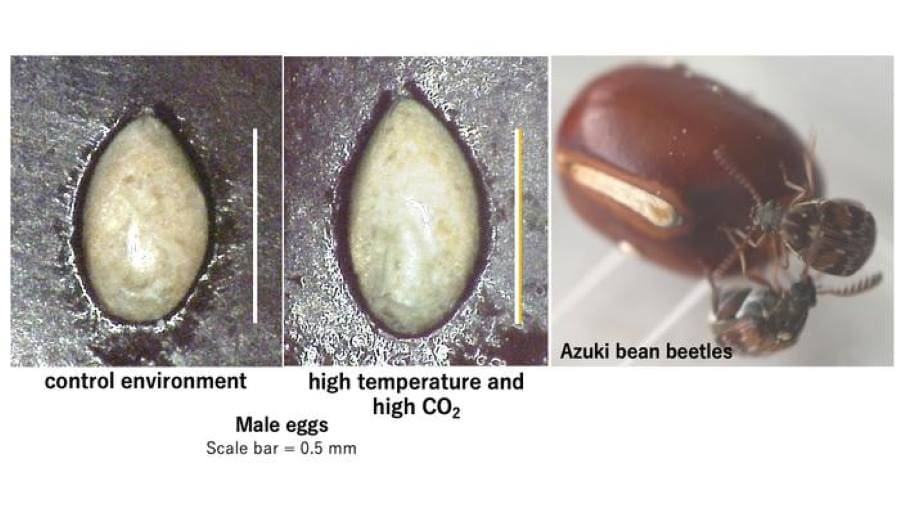
Interestingly, the adult lifespan of the offspring was influenced not by egg size, but by environmental conditions, sex, Wolbachia infection, and development time. In fact, eT&CO2 reduced male lifespan but had no significant effect on females.
This study is the first to demonstrate sex-specific egg size changes due to Wolbachia infection in a species with chromosomal sex determination. Further research is needed to elucidate the mechanisms driving this sex-dependent change aided by Wolbachia coinfection.
“From a pest control perspective, targeting Wolbachia may be a strategy worth exploring. However, because nearly half of all insect species are infected with Wolbachia, non-selective use of bactericides could threaten non-pest insects as well,” concludes Tuda. “A nature-positive approach is essential as we adapt to a changing climate.”
Journal Reference:
Leroy, E., Gao, S., Gonzalez, M. et al., ‘Wolbachia infection facilitates adaptive increase in male egg size in response to environmental changes’, Scientific Reports 15, 13213 (2025). DOI: 10.1038/s41598-025-96680-6
Article Source:
Press Release/Material by Kyushu University
Featured image credit: Gerd Altmann | Pixabay




